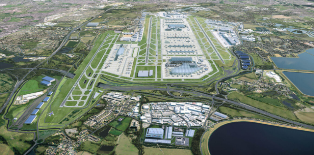2022 was a year of ups and downs for London Heathrow Airport, which returned to its throne as Europe’s busiest airport (by ASKs). While passenger numbers more than tripled from 19.4 million to 61.6 million, the airport faced a rocky summer marred by capacity limits and disruptions across the board. Heathrow continued to operate at a loss, although the figure dropped by nearly half to a pre-tax loss of £684mn ($817mn). Here’s a closer look at the results and why the year panned out this way.
After three brutal years, London Heathrow Airport (LHR) is finally on its way to a full recovery. Losses fell from £1.27 billion ($1.51bn) in 2021 to £684mn ($817mn) in 2022, with adjusted EBITDA rising by 338% in the same period. On the passenger side, things looked rosier, with 61.6 million passengers arriving, departing, or transiting through LHR, 76% of 2019 levels.
Revenue increased impressively to £2.93 billion ($3.5bn), up 140% from the previous year, allowing the airport to cut its losses and invest in desperately needed new staffers and facilities for passengers. The airport pointed to several factors for staying in the red, namely inflation and lower passenger numbers than expected.
Outgoing CEO John Holland-Kaye highlighted the airport’s many achievements this year, especially the winter, “2022 may have been a year of recovery, but 2023 is shaping up to be a year of renewal for Heathrow. Our teams have already delivered a successful Christmas and half-term getaway, and with a great investment plan in place, we are determined to once again rank in the top 10 airports for service. I couldn’t be prouder of how far Team Heathrow has come in my nine years as CEO – from transforming customer service, to securing Parliamentary approval for expansion to surviving two years of border closures and rebuilding the business. My successor will take on a fantastic team who are making Heathrow a world leading hub that Britain can be proud of.”
Heathrow will be hoping to continue its upward trajectory into 2023 as well. With the last of the major markets like China opening their doors at the start of the year, flight traffic should start closing in on pre-pandemic levels, as well as passenger levels. However, the issue won’t be demand but rather the ability to cope with it.
Travelers will vividly remember the meltdown of last summer, where Heathrow capped traffic at the peak of the period due to a lack of staff. While the winter holidays went much better, the airport is racing to staff up before the summer. Indeed, Europe’s biggest airport has recruited 25,000 people in the last 18 months to staff everything from aircraft tow trucks to service desks.
Alongside managing traffic, the airport is focusing on becoming more sustainable and supporting airline programs for emission-offset flights. However, several key fights are brewing, including one over the increase of landing charges, which has pitted airport and airline executives against each other, and the long-standing expansion plan. Watch closely as 2023 shapes up to be a decisive year for Heathrow’s long-term future.
Simple Flying




